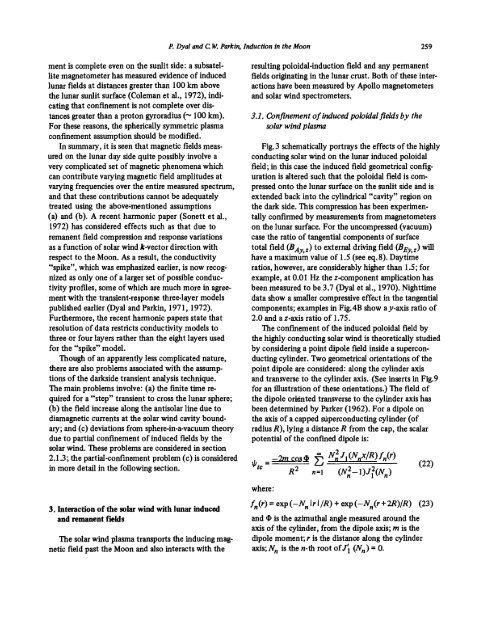global electromagnetic induction in the moon and planets - MTNet
global electromagnetic induction in the moon and planets - MTNet
global electromagnetic induction in the moon and planets - MTNet
Create successful ePaper yourself
Turn your PDF publications into a flip-book with our unique Google optimized e-Paper software.
P. Dyal <strong>and</strong> C. W. Park<strong>in</strong>, Induction <strong>in</strong> <strong>the</strong>Moon 259<br />
ment is complete even on <strong>the</strong> sunlit side: a subsatel- result<strong>in</strong>g poloidal-<strong><strong>in</strong>duction</strong> field <strong>and</strong> any permanent<br />
lite magnetometer has measured evidence of <strong>in</strong>duced fields orig<strong>in</strong>at<strong>in</strong>g <strong>in</strong> <strong>the</strong> lunar crust. Both of <strong>the</strong>se <strong>in</strong>terlunar<br />
fields at distances greater than 100 km above actions have beenmeasured by Apollo magnetometers<br />
<strong>the</strong> lunar sunlit surface (Coleman et al., 1972), mdicat<strong>in</strong>g<br />
that conf<strong>in</strong>ement isnot complete over dis-<br />
<strong>and</strong> solar w<strong>in</strong>d spectrometers.<br />
tancesgreater than a proton gyroradius (‘~100 km). 3.1. Conf<strong>in</strong>ement of <strong>in</strong>duced poloidal fieldsby <strong>the</strong><br />
For <strong>the</strong>se reasons, <strong>the</strong> spherically symmetric plasma<br />
conf<strong>in</strong>ement assumption should be modified.<br />
solar w<strong>in</strong>d plasma<br />
In summary, it is seen that magnetic fields meas- Fig. 3 schematically portrays<strong>the</strong> effects of <strong>the</strong> highly<br />
ured on <strong>the</strong> lunar day side quite possibly <strong>in</strong>volve a conduct<strong>in</strong>g solar w<strong>in</strong>d on <strong>the</strong> lunar <strong>in</strong>duced poloidal<br />
very complicated set of magnetic phenomena which field; <strong>in</strong> this case <strong>the</strong> <strong>in</strong>duced field geometrical con-figcan<br />
contribute vary<strong>in</strong>g magnetic field amplitudes at uration is altered such that <strong>the</strong> poloidal field is cornvary<strong>in</strong>g<br />
frequencies over <strong>the</strong> entire measured spectrum, pressed onto <strong>the</strong> lunar surface on <strong>the</strong> sunlit side <strong>and</strong> is<br />
<strong>and</strong> that <strong>the</strong>se contributions cannot be adequately extended back <strong>in</strong>to <strong>the</strong> cyl<strong>in</strong>drical “cavity” region on<br />
treated us<strong>in</strong>g <strong>the</strong> above-mentioned assumptions <strong>the</strong> dark side. This compression has been experl<strong>in</strong>en-<br />
(a) <strong>and</strong> (b). A recent harmonic paper (Sonett et al., tally confirmed by measurements from magnetometers<br />
1972) has considered effects such as that due to on <strong>the</strong> lunar surface. For <strong>the</strong> uncompressed (vacuum)<br />
remanent field compression <strong>and</strong> responsevariations case <strong>the</strong> ratio of tangential components of surface<br />
as a function of solar w<strong>in</strong>d k-vector direction with total field (BAY,Z) to external driv<strong>in</strong>g field (BEy,z) will<br />
respect to <strong>the</strong> Moon. As a result, <strong>the</strong> conductivity have a maximum value of 1.5 (see eq.8). Daytime<br />
“spike”, which was emphasized earlier, is now recog- ratios, however, are considerably higher than 1.5; for<br />
nized as only one of a larger set of possible conduc- example, at 0.01 Hz <strong>the</strong> z-component amplication has<br />
tivity proffles, some of which are much more <strong>in</strong> agree- been measured to be 3.7 (Dyal et al., 1970). Nighttime<br />
ment with<strong>the</strong> transient-response three-layer models data show a smaller compressive effect <strong>in</strong> <strong>the</strong> tangential<br />
published earlier (Dyal <strong>and</strong> Park<strong>in</strong>, 1971, 1972). components; examples <strong>in</strong> Fig. 4B show a y-axis ratio of<br />
Fur<strong>the</strong>rmore, <strong>the</strong> recent harmonic papers state that 2.0 <strong>and</strong> az-axis ratio of 1.75.<br />
resolution of data restricts conductivity models to The conf<strong>in</strong>ement of <strong>the</strong> <strong>in</strong>duced poloidal field by<br />
three or four layers ra<strong>the</strong>r than <strong>the</strong> eight layers used <strong>the</strong> highly conduct<strong>in</strong>g solar w<strong>in</strong>d is <strong>the</strong>oretically studied<br />
for <strong>the</strong> “spike” model, by consider<strong>in</strong>g a pO<strong>in</strong>t dipole field <strong>in</strong>side a supercon-~<br />
Though of an apparently less complicated nature, duct<strong>in</strong>g cyl<strong>in</strong>der. Two geometrical orientations of <strong>the</strong><br />
<strong>the</strong>re are also problems associated with <strong>the</strong> assump. po<strong>in</strong>t dipole are considered: along <strong>the</strong> cyl<strong>in</strong>der axis<br />
tions of <strong>the</strong> darkside transient analysis technique. <strong>and</strong> transverse to <strong>the</strong> cyl<strong>in</strong>der axis. (See <strong>in</strong>serts <strong>in</strong> Fig.9<br />
The ma<strong>in</strong> problems <strong>in</strong>volve: (a) <strong>the</strong> f<strong>in</strong>ite time re- for an illustration of <strong>the</strong>se orientations.) The field of<br />
quired for a “step” transient to cross <strong>the</strong> lunar sphere; <strong>the</strong> dipole orisnted transverse to <strong>the</strong> cyl<strong>in</strong>der axis has<br />
(b) <strong>the</strong> field <strong>in</strong>crease along <strong>the</strong> antisolar l<strong>in</strong>e due to been determ<strong>in</strong>edby Parker (1962). For a dipole on<br />
diamagnetic currents at <strong>the</strong> solar w<strong>in</strong>d cavity bound- <strong>the</strong> axis of a capped superconduct<strong>in</strong>g cyl<strong>in</strong>der (of<br />
ary; <strong>and</strong> (c) deviations from sphere-<strong>in</strong>-a-vacuum<strong>the</strong>ory radius R), ly<strong>in</strong>g a distance R from <strong>the</strong> cap, <strong>the</strong> scalar<br />
due to partial conf<strong>in</strong>ement of <strong>in</strong>duced fields by <strong>the</strong> potential of <strong>the</strong> conf<strong>in</strong>ed dipole is:<br />
solar w<strong>in</strong>d. These problems are considered <strong>in</strong> section 2<br />
2.13; <strong>the</strong> partial-conf<strong>in</strong>ement problem (c) is considered<br />
<strong>in</strong> more detail <strong>in</strong> <strong>the</strong> follow<strong>in</strong>g section.<br />
— —2m cos ~,<br />
2 n=1<br />
“~c— R<br />
Np~J<br />
1 (N~x/R)f~(r) (N2—DJ2(N<br />
22<br />
‘ n / 1’ n<br />
where:<br />
f (r) = exp (—N Jr I /R) + exp (—N (r + 2R)/R) (23)<br />
3, Interaction of <strong>the</strong> solar w<strong>in</strong>d withlunar mduced ~1 fl fl -<br />
<strong>and</strong> remanent fields <strong>and</strong> 4 is <strong>the</strong> azimuthal angle measured around <strong>the</strong><br />
axis of <strong>the</strong> cyl<strong>in</strong>der, from <strong>the</strong> dipole axis;m is <strong>the</strong><br />
The solar w<strong>in</strong>d plasma transports <strong>the</strong> <strong>in</strong>duc<strong>in</strong>g mag- dipole moment;r is <strong>the</strong> distance along <strong>the</strong> cyl<strong>in</strong>der<br />
netic field past <strong>the</strong> Moon <strong>and</strong> also <strong>in</strong>teractswith <strong>the</strong> axis; N~is <strong>the</strong> n-th root off 1 (Nn) = 0.

















